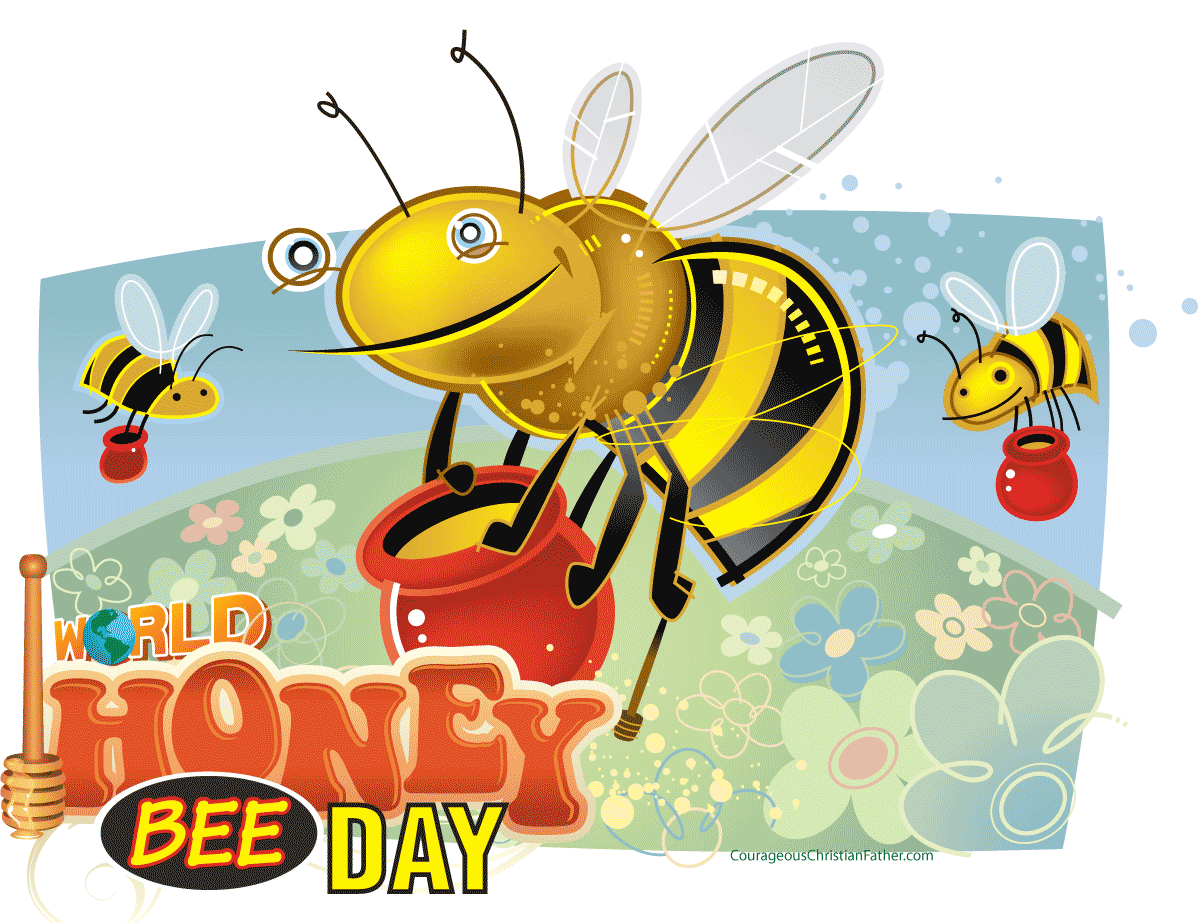World Honey Bee Day – a day set aside for honey bees. #HoneyBeeDay

The purpose of this day is to raise awareness day when beekeepers, beekeeping clubs and associations, and honey bee enthusiasts from all across the United States celebrate honey bees and recognize their contribution to our everyday lives as a means of protecting this critical species. Per WikiPedia
Honey bees do sting, but only if they perceive a threat – damage to their hive or being swatted at. Since they seek sweet nectar, sugary drinks and sweets will attract honey bees when flowers are not blooming yet. Keep beverages covered. If a honey bee comes close, either hold still or move slowly away. The honey bee will fly along to the next sweet thing as long as it doesn’t feel threatened.
National Day Calendar
This day is held annually on the third Saturday in August. In 2019, it will be held on August 17.
World Honey Bee Day began as National Honey Bee Day in 2009 with a proclamation issued by the Secretary of Agriculture, Thomas J. Vilsek.
Future Dates:
- 2020 – August 15
- 2021 – August 21
- 2022 – August 20
- 2023 – August 19
- 2024 – August 17
- 2025 – August 16
Honey Bees make some yummy honey. Check out the benefits of honey.
Why honeybees need protection
Honeybees flitting from flower to flower is one of the first signs that warm weather has arrived. Honeybees are a welcome presence in the garden, pollenating plants and contributing to local honey supplies.
Despite their importance in the ecosystem, honeybees are in grave danger. In 2014, U.S. President Barack Obama created a task force comprised of various agencies to address the growing issue of rapidly diminishing honeybees and other pollinating insects. This initiative was a response to reports from American beekeepers indicating hive deaths have been on the rise, gravely affecting the honeybee population. Honeybees pollinate many fruit trees, nut plants and vegetables, playing a crucial role for many nations’ food industries.
In addition to government involvement and honeybee conservation methods designed by environmental agencies, there are many things that regular citizens and homeowners can do to protect honeybees this summer. The Environmental Protection Agency and the Pesticide Action Network offer these tips.
· Use caution when applying any pesticides to home gardens. Be especially cautious when applying pesticides when bees are likely to be flying. If you must apply pesticides, do so only after dusk.
· Stagger your planting throughout the growing season. Rather than planting everything at once, stagger planting for flowers and other plants that have blooms. This gives bees plenty of pollen sources throughout early summer and into fall.
· Provide clean sources of water. A small garden feature or a rainwater collection is enough to provide bees with a drink when needed.
· Honeybees and other bees require some sort of shelter. Dead trees and plants provide adequate shelter, so don’t be so tempted to pull out all of the undergrowth in the name of aesthetics.
· Plant a garden that will attract bees. Resources for planting a bee-friendly garden can be found by visiting http://www.panna.org/sites/default/files/Bee-FriendlyGardening_PAN.pdf.
· If you come across a hive, leave it alone. It’s best not to disturb a hive and honeybee colony. If bees are located where they can become a nuisance, contact a local bee expert to see if the hive can be moved.
· Think about becoming a beekeeper yourself. There are many different resources available to help you get started.
Bees are being threatened at an alarming rate. Educating yourself about what to do to protect honeybees can help to restore the valuable honeybee population.
Compliments of MetroCreative. TF166142
About the Author
Discover more from Courageous Christian Father
Subscribe to get the latest posts sent to your email.



I am a beekeeper.
The comment above about the sugary drinks…. it “bugs me that constantly folk mistake yellow jackets for bees and refer to them more often than not as “bees. ”
If you are drinking soda or eating something (sugary or not) and you are getting bothered, or if you are around a trash can and see yellow flying “bees” these are NOT bees!!!!!! These are a type of hornet known as the Yellow Jacket. They produce no honey. We get stung and blame the bee. Bees however are smaller, busier (smarter in my opinion), and furry… they are too busy gathering nectar from flowers than to be harassing folk with their sodas. In very early spring, as mentioned above… they might be gathering sap from pine trees… at least mine do. And beekeepers usually feed their bees in early spring and late fall, and consequently stay pretty close to the hive. You are only likely to get stung if a) you are a beekeeper going in their hive and make a mistake, or b) you sit or step on one! Bees are quite gentle and will lose their life if they sting, but they are trying to defend their home, their queen, and their brood (children)..
Yellow Jackets, on the other hand, are aggressive. They don’t die if they sting because they sting to kill their prey. They are hunters as well as scavengers and will hunt insects and…. bees! Food chain, baby… they are predators.
So please, on Bee Day…. now that you know the difference… how about calling a Yellow Jacket for what it is and quit blaming the bee for harassment when we are drinking “sugary drinks?” That would be a great thing to do for the bee!
Thanks for the comment to add to this article. Yes, people do confuse the two.